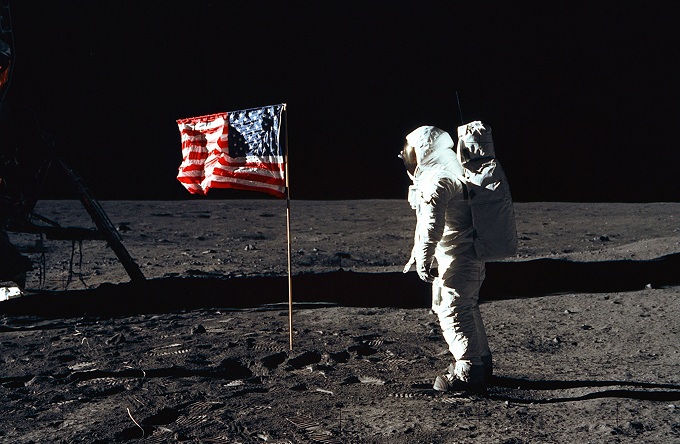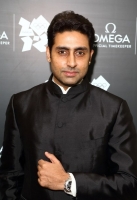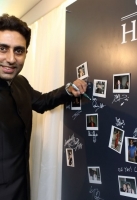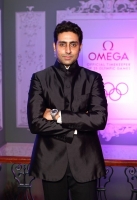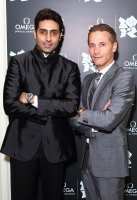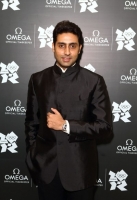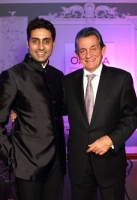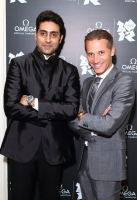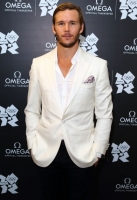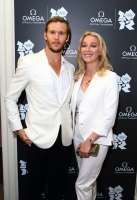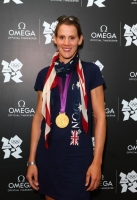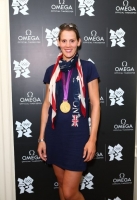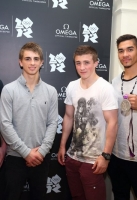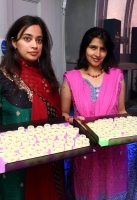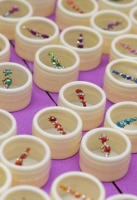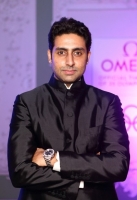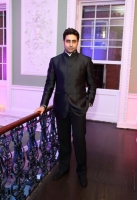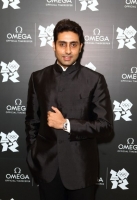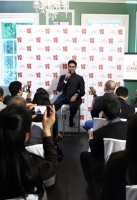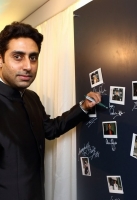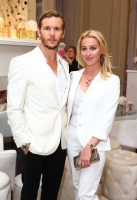The Hunger Games Signed Photo Competition
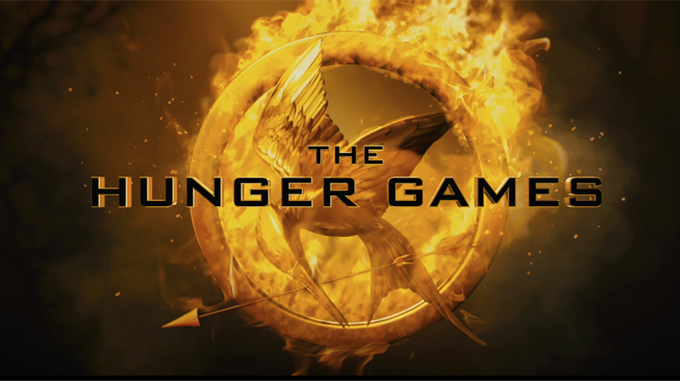
In celebration of the amazing London 2012 Games we have a very special competition for fans of The Hunger Games. It’s your chance to win a stunning movie still signed by Miss Katniss Everdeen herself, the beautiful Jennifer Lawrence.
The rules are very simple and all you have to do to be in with a chance of winning is follow the instructions below.
Step 1: Follow us on Twitter @RedCarpetNewsTV – https://twitter.com/RedCarpetNewsTV
Step 2: Tweet us the following message to enter the prize draw:
@RedCarpetNewsTV May the odds be ever in MY favor #KatnissCompetition #HungerGames
Step 3: Check back on Twitter or here at www.redcarpetnewstv.com where we’ll be announcing who’s won.
* It’s one entry per Twitter account, but of course if you want to get your friends and family to throw their Twitter names into the hat to stack the odds in your favor it’s a legitimate tactic.
We’ll be picking the very lucky Tribute on 12th August at the climax of the Closing Ceremony of London 2012. Till then Happy Olympic Games and may the odds be ever in your favor….
The prized photo pictured below as well as our own Russ with the lovely Jennifer Lawrence in London:
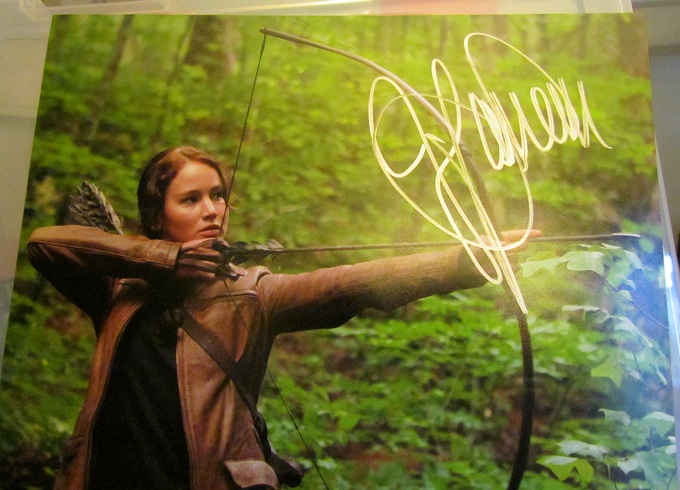
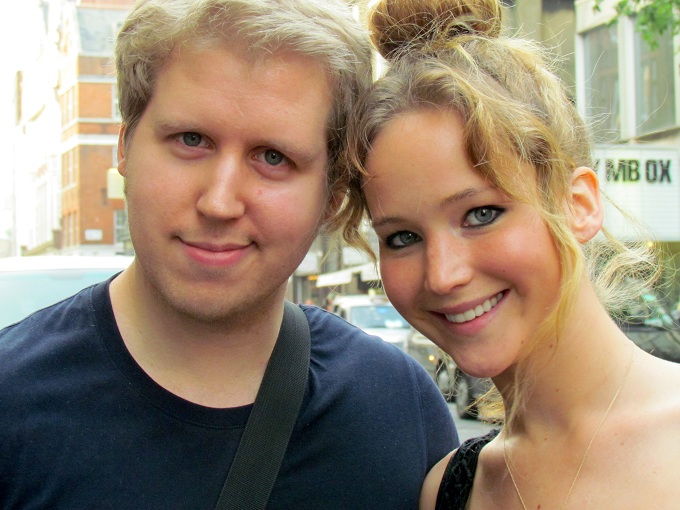
As an extra treat check out our video interviews below with Hunger Games Tributes Rue (Amandla Stenberg) and Thresh (Dayo Okeniyi ) below:
Abhisek Bachchan hosts Bollywood Olympic Party

Bollywood superstar Abhishek Bachchan hosted a Bollywood themed night of celebration at the exclusive venue of the official Olympic Timekeepers Omega last night. Olympic star athletes and inspired celebrities partied late into the night while nibbling on Indian delicacies and dancing to a steady stream of bhangra music.
Sporting stars in attendance included Team GB’s Men’s gymnastics team and Gold medallist USA Rower Caryn Davies. Members of the incredibly successful Team GB rowing team enjoyed a well-earned night of celebration, including Britain’s first London 2012 gold medallists Helen Glover & Heather Stanning.
Media guests in attendance also included Preeya Kalidis and smouldering True Blood star Ryan Kwantan, who plays heartthrob Jason on HBO’s top rated Vampire series.
Check out the exclusive gallery of party pictures below:
Olympic Gold Medalist Caryn Davies Interview
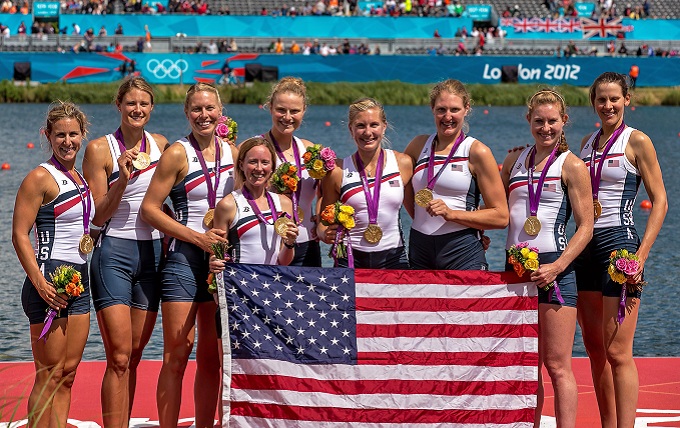
Team USA Rowing star Caryn Davies won a Gold medal at the London 2012 Olympic Games competing in the Women’s Eight. Adding to the previous Gold she took home at the last Beijing Olympics in 2008, this makes her an astonishing double Olympic Champion.
Proudly wearing her new Gold Medal, Caryn spoke to our roving reporter Russ at yet another amazing night at Omega House. A Bollywood themed party hosted by real life Bollywood superstar Abhishek Bachchan.
Caryn talks about the exhilaration of wining Gold, shares her favourite Olympic memory and gives her message to the next generation of inspired athletes whilst announcing her own plans to retire from rowing as soon as the Games officially close.
How does it feel to have won Olympic Gold?
It’s actually very tiring, I do think I’ve recovered from my race yet and it hasn’t set in yet but it feels amazing and I’m really looking forward to enjoying London.
Can you describe the range of emotions you feel at that moment when you know you’re a winner?
This time around the greatest emotion was relief because we were actually favourites coming into the race. So I knew that anything less than Gold this time would have been a disappointment. Four years ago when we won Gold for the first time that was more of disbelief. Like Oh my goodness I’m an Olympic champion and I will be forever. It was quite an amazing moment.
Speaking as a double Olympic champion, what do you think it is that distinguishes the Olympics form all other sporting contests?
I think actually it’s the friendships formed. To start with it’s about the friendships amongst teammates. Those girls that I rowed with will be my friends for life. But also the people that I meet here from other countries, the athletes, the coaches, the staff; everyone is just working so hard for one goal and there’s no bond like that.
How do you think London has compared to other Olympics?
I think the crowds are incomparable. Especially at the rowing, because rowing is one of Britain’s great sports. Everyone seems to know what it’s about and the crowd was just probably the loudest I’ve ever heard and I think that was probably the best part.
Fans will have their own favourite Olympic memories, where there any particular Olympic moments which inspired you when you were younger?
My favourite Olympic moment was actually in 1998 at the Men’s Downhill. When Hermann Maier crashed. It was an absolutely spectacular crash and at the time I was a skier so I was watching very avidly. At first you thought, oh my goodness he might be dead. He went flying through the air sideways and went through three fences before he came to a stop. He sat up, got to his feet and went “I’M OKAY I’M OKAY!!!”. Then the next day he went on to win Gold in the giant slalom. So that was pretty incredible. It was just such a good story of coming back against the odds and overcoming obstacles.
The Olympics gives us those amazing moments but how much have you had to sacrifice to be a part of it?
I think the biggest sacrifice that I and most of our teammates have made I in our careers. All of us are college graduates and we’re earning about 10,000 dollars a year rowing, when we could probably be earning closer to 100,000 dollars if we had continued with our careers. So my mom likes to think of it as playing Peter Pan. Eventually I’m going to have to get a real job; in fact I plan to right after these Games. I plan to retire and get a job. But I think the most difficult thing has been living out of a suitcase on a shoestring budget, but it does teach you want you can do with very little.
Aside from you Olympic glory what have been the proudest moments of your sporting career?
Well I wasn’t living out of a suitcase at the time but my proudest athletic achievement was beating all the boys in the third grade arm wrestling competition. That can be verified by my third grade gym teacher. Though I didn’t get a medal for that I only got bragging rights!
What does an Olympic Medal actually feel like?
It’s definitely the heaviest medal I have ever worn and it might cause me to have a permanent lean forward for the next few weeks as I struggle under the weight of it. But I pretty much wear it under my shirt at all times and it gets warm. It pretty much seems to have a glow of its own, a warm glow.
Do you have a message for young fans who’ve been inspired by the Olympics, particularly when watching the magnificent rowing?
Yeah I think the biggest message is to have fun, because if you find something that you love and really enjoy doing then that’s when you’re willing to put in the hours and effort to get really good at it an reach the highest levels!
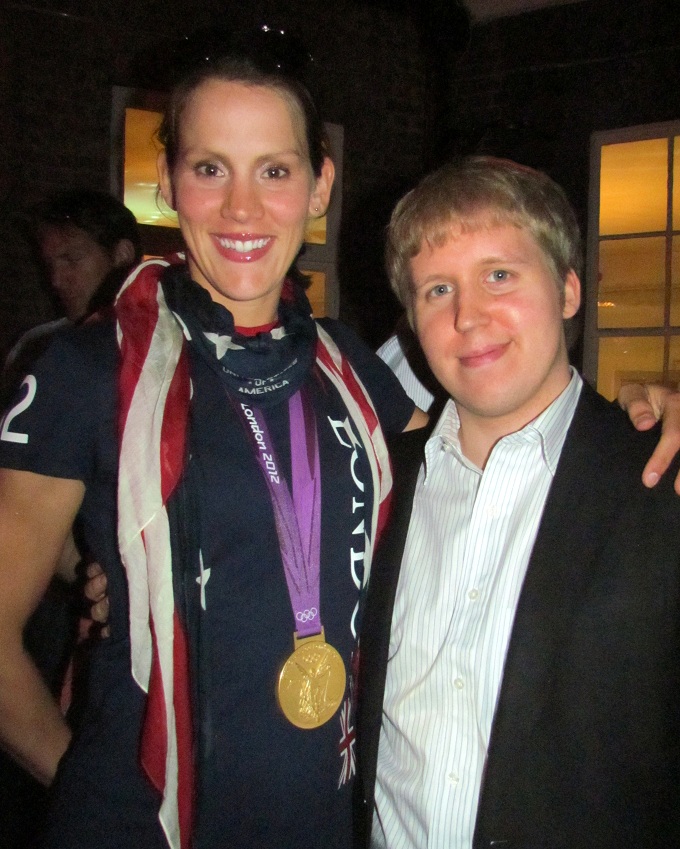
Buzz Aldrin Interview Space, God & The Future
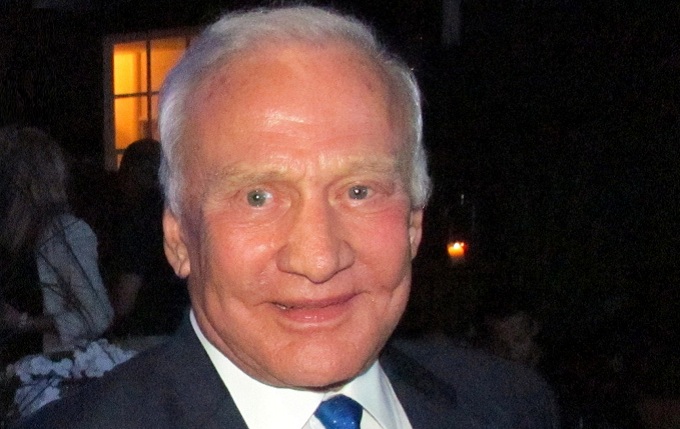
Astronaut Buzz Aldrin one of few human beings to ever venture into space and set foot on the surface of the Moon spoke to a lucky crowd of people at Omega House, the exclusive venue of official Olympic timekeepers Omega.
Answering questions he spoke about the future of space exploration, Missions to Mars, how to inspire the next generation an how his own adventures have impacted his belief and relationship with God.
Read our the full transcript of the fascinating interview with one of the most extraordinary figures in human history below:
It’s been an honor and inspiration to hear you talk with passion and eloquence about the value of space exploration, what do you consider the greatest gift that it has brought mankind so far and where do you like to dream it may one day take us as we continue that adventure out beyond the reaches of our solar system?
Well I can see you’re a futurist also. I think it gives us hope it gives us a challenge, something to really strive for. Kennedy said we were going to go to the Moon within a decade and I hope that a president can say on the 5oth anniversary of us landing on the Moon it’s taking two decades to get to Mars. That means that we’ll get there before 2040, depending on who the president is. I intend to point out to him that he should say something like that on the 50th anniversary in 2019.
Actually I’ve written a science fiction story about going to the stars. About going to Alpha Centori the closest star. Rather than outline all the advances we have to do to be able to go there. It’s much easier for the alien civilisation that’s already there to come here and give us the knowledge to be able to go there. That will be coming out in a series of episodes soon.
What impact has space travel had on your belief in and relationship with god?
Well I thought about doing things for demonstration, I’m a role model I’m not a teacher. I can’t speak to every kindergarten kid in the world but I do things on television maybe that reach them. I write a lot of books. I took communion on the Moon. I think that I’ve moved a bit beyond that and Einstein called it a cosmic spiritual sense of the origin of the universe. The majesty that’s there and who we are in this little sphere there’s got to be something intelligence behind that.
There are certain constants, certain numbers that re-occur in the description of the laws of nature. If those constants were different from what they are then it wouldn’t work. So those constants are fundamental to what we do, there’s an intelligence behind that. In the meantime we look for things that maybe cause danger so we have a God of fear, then we move into morals and ethics and most of the people are kind of there right now, but they’re human concepts.
A number of people, I imagine Steven Hawking and Einstein get to think a little bit beyond because they’re involved in how did it all begin, the big bang.
Where there ever any moments of doubt during you many amazing missions, where you ever scared?
We fly jet airplanes and the engine can quit just as you get to the end of the runway. So you face unforeseen events, espically in combat. You learn to suppress concern about that. Sure there are things to be worried about but the worry doesn’t help until it happens, then you need to do something about it, whatever it is. So don’t bother worrying about it before something goes wrong.
What made you choose to wear your Omega watch when you landed on the surface of the moon?
The watches that we have, I felt were personal gifts form the government. NASA feels little differently about things like that now. I felt it was a good thing to wear what I had as part of your culture out on the moon. Despite the fact it was probably about the most useless thing you have on the surface of the moon to know what time it was in Houston Texas.
Do you think that we should postpone missions to Mars to explore planets of Moons which we think may be habitable?
I rode on Air Force one down to Florida and I was kind of quoted by President Obama as saying “been there, done that”. That’s not what I would say if I was President, I would be a little more explicit. If we spent the money to go back to the moon we know by analysis of what it takes we would probably be greeted by the Chinese who were there, so now we’re second in being second to go back to the Moon. While were doing that the Russians may get to Mars. I may just be supposing, but they don’t really care about building up a permanent base, they care about being first.
That’s what makes the difference to a lot of the people of the world. That they’re sacrifices and hardships, whether it’s in China or Russia, are worth it because they’re the leader in the world. Mars is the most earth like object. The Moon has no atmosphere it’s a vacuum, it’s very hot or very cold. We can go there and bring someone back in a couple of days if we want. So that’s the way we’ll deal with the Moon, when we decide it is time to go back to the Moon.
We have large credits in the United States about the Moon, more than any other country; therefore we should be the leader of the international lunar development authority or corporation. That way we should pick where the main base should be and we can help assemble it robotically from a stable place not to far away from the Moon where we’ll go to. Where we can eventually have refuelling depots and do the things that will help us in the stepping stones that will get us to Mars. That’s what I’ve been dedicated to doing.
I discovered the possibility 27 years ago in 1985 by first looking at the Moon in repeating cycling orbits. I was disappointed when it was pointed out to me that that it’s not necessary to build a big ship to do that. We can do just what we did with Apollo. This idea of winging around one object and another would be great for tourism. You don’t have to keep putting up the cycler you just hook up to it as it swings past the earth. It goes round the Moon and comes back, it goes out again a second time and the Moon isn’t there but if it goes out a third time I will be. So we can reuse what can become a commercial business.
It was pointed out to me at that time, why don’t you look at Mars? So I looked at Mars and it turns out that low and behold it isn’t that far. If we really look at the basics to get something that swings by the earth and five months later swings by Mars. Just 21 days later it would swing by the earth. It could keep doing that. It takes 26 months for the Earth and Mars to be in the right place to leave one and get to the other. That’s a big deal. That’s important to me that I was the first one to discover that.
That and ways like that are the ways we’re going to go to Mars. I won’t be around to see that but I’ll help in the planning of the mission that will be able to take us there. Probably we’ll get there hopefully before 2040.
In August there will be and Austrian man jumping out of a plane at 120,000 feet with a parachute what do you think of that?
He’s crazy! What altitude? 120,000 with a balloon? Why would he want to do that? It’s like jumping out a perfectly good plane. Humans will always want to set a record; here we are at the Olympics people are out there trying to set a record about something or other. I remember when I was a youngster there was a world’s fair in New York in 1939. My father took me there and there was a parachute ride where you were pulled up and then dropped down on wires. You didn’t actually fall. I rode up there with a guy who had gone up in a balloon to 70,000 feet and he was smart enough not to jump out of it.
Why do you like coming to the Olympics so much?
Well I was at the Vancouver Olympics and I was asked to President of Omega to present an Omega watch to the figure skating champion. About a year later the two of us were on dancing with the stars. With his sense of rhythm he did much better than me.
How important do you feel a focus on science in education is?
Apollo put us and the USA at the top in those subjects of Science, Engineering, technology and Maths. But we don’t stand there any more, we’re quite a ways down in comparison to the other nations in the world and we somehow need to stimulate the youth of the nation to be a bit more interested in those subjects because those subjects determine the future of a nation. The economy and entrepreneurship, innovation means you aim for more than being in a rock band.
The children of nations like China and Japan at least are dedicated students; they come to our universities and learn and go back. But they don’t have to do that anymore, they don’t need to come to MIT because they have their own MIT back in China now. We’ve got someone from MIT who speaks Russian who’s helping Russian set up an MIT that’s Moscow Institute technology. We’re gonna lose this game some time if we don’t get our act together. That’s the economy, jobs and short term political things. But as a nation we have to look beyond to the future and that’s why to me going back to the Moon is nothing, it’s a waste of Money but going to Mars is very important.
How do you think our priorities have changed?
We’ve moved and changed, I’m not sure it’s to the better in those subjects that we’ve declined our performance relative to other people in the world. We want it now, we’re very short term politically, culturally and whatever it is people want it now you can’t get it now all the time, you have to think ahead. The nations that think ahead are going to be planning for ahead and it takes a while to develop things. Culturally I can’t carry a tune and I can’t dance too well either. But what I know how to do it back of the envelope seethes of orbits and what kind of spacecraft do we need to do certain missions and that’s my life really. I do this occasionally so I can eat and drive a convertible.
How do you think the advance of technology is helping or hindering our advancement?
Computers allow us to squeeze the most out of everything. Like Google letting us look up things, I guess that does make us a little lazy when it comes to reading books and doing things the hard way. Understanding how the hell those things work, put your finger on it all sorts of things happen, but how do they happen? Pretty soon we won’t know. They’ll just be a few people who do. Cars are becoming so complicated when you lift the hood up you can’t tell where the oil is or how to change the fluid!
How do you think we inspire the next generation?
You have to start young. Then you have to keep it moving along with parental inspiration. My father was an aviation pioneer and knew a lot of the leading people in aviation. So as a teenager I really followed closely world war two and the strategy behind things that were happening, particularly airplanes and what they could do. So that was where I wanted to start. Then beep beep beep, sputnik goes up other and now I wanted to learn how to do that, to be part of that. It was a pretty small group and it’s going to be a small group of people that go to Mars.
It’s not going to be tomorrow it will be a number of years. So a lot of people are going to get weary and tired, so we have to know what the stepping stones are. When I submitted a plan for the future we needed to send a spacecraft out and come back a year later. There’s a very easy orbit that will do that. It’s a free return. If the engine stops halfway through then you just make a bigger circle. But make it fascinating I said let’s take this orbit and make it fly by a comet.
Plan on flying by the comet and people on the earth will see the tail of the comet and as we approach it to fly by we’ll have the upper stage of the rocket crash into the comet. Well take pictures of it and send it back in 3D for people to see that. When we go to the stable refuelling base close to the Moon, why not do a couple of cycling orbits first and then stop there. You’ll excite the people about what you’re doing. We have to do that at least once a year or more frequently if we can.
Do you have a favourite technological innovation to come from the space programme?
I’ve got an IPhone here and it has a battery. That’s the kind of thing that came out of the space programme. But don’t think they just came from NASA. Most of those things came from miniaturisation of the components needed by the air force for missiles. Then what worked well was tested by NASA who used those things. The underwear that we wore had little tubes that circulated cold water, but deep sea divers have a much better suite that have much more tubes even going down to their finger to keep them warm. So not everything comes from NASA we bring things that entrepreneurs develop and look at what we need to use the things that really enhance the mission. Of course there’s a lot of competitive that goes on to try and do a mission. Of course there is a competition in trying to do a certain mission.
There is co-operation in space at the space station but it’s tough co-operation between the European Nation, they need to get approval every so often from the ministries of all the nations come together to decide who’s going to contribute and how much. Then depending who contributes how much they get some work to do on the space station. It’s very cumbersome and you really need national leadership to do co-operative things.
We thought that the space station that President Reagan announced was going to be ready in 8 years for 8 people and cost about 8 billion dollars. We only have 6 people up there and we can’t even get there in our rockets and it cost 100 billion dollars. So we don’t always estimate correctly but the lunar programme came in on time and on budget but it really can be done with strong leadership and a strong co-operative venture where everyone is working on the end result.
Is co-operation or competition more useful as a driving factor for space exploration?
To get where we are today. My book that I’m writing now is about that, we did pretty well until the Apollo programme. We recovered well from the fire that killed the three astronauts. It looked like maybe Russia would send one astronaut around the Moon for one orbit and then come back, splashing down in the ocean. So we changed our mission to expedite it, the second time we flew on the big rocket and people got on the Apollo capsule we went to the Moon and orbited the Moon without landing. That really inspired people at the time in 1968. So you can do things for a variety of reasons. Some are co-operative and some are competitive. It would be nice to compete on the basics internationally. Then pick the best and co-operate on the best.
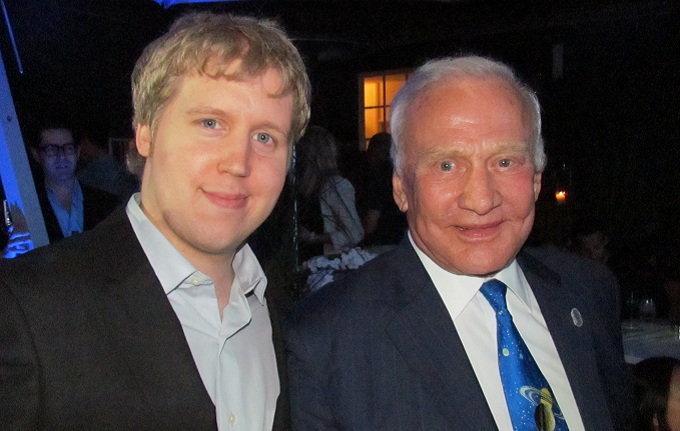
Buzz Aldrin Tells Moon Landing Story
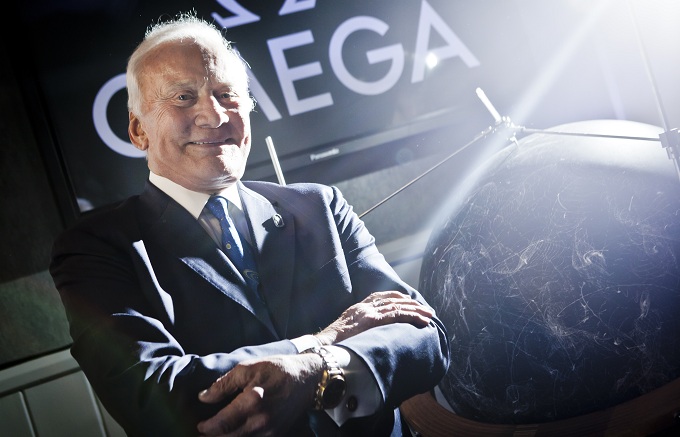
Buzz Aldrin was the lunar module pilot on Apollo 11 the first manned lunar landing in history. He was the second human being to set foot on the surface of the Moon, following mission commander Neil Armstrong. His story and spirit of adventure remains one of the most inspiring in mankind’s history.
Swiss watch masters Omega were responsible for making the timepiece he wore on his historic lunar landing and brought him to the London 2012 Olympics. In the intimate surroundings of the luxurious Omega House, Buzz Aldrin recounted his extraordinary life story and shared details of his own experiences of one of the most iconic and significant moments in human history.
Astronaut Buzz Aldrin spoke about the birth of the space race, the challenges of reaching the lunar surface, why Neil Armstrong was the first to set foot on the Moon and explains his own iconic first lunar words “Magnificent Desolation”. Finally Buzz speaks of his continuing adventures on earth and his hopeful ambitions for the continued exploration of space by an ambitious and excited next generation. Read the full speech below:
Good afternoon and welcome to the explorer space event at the Omega House. I’d like to thank Omega for inviting me to come to the Olympics one again and for the opportunity to share my story with you this evening. I truly appreciate our partnership and their support of the space program. Engaging in mutually valuable partnerships is the key to pioneering new frontiers, whether it is the far reaches of space or keeping perfect time. You’ll notice I have two watches on!
Luck has always been a key element in my life. I’ve been blessed to be in the right place at the right time. But along with timing, keeping a good balance is necessary as is viewing yourself as part of a team. Just as we did with Apollo. Before I get ahead of myself, let me tell you a bit about my grand adventure that never would have happened without the support of many people working together towards a shared goal.
Mankind has dreamed for centuries of reaching space, the moon and even the stars. But it wasn’t until the 20th Century that man took his first powered flight in 1903 on a windy morning the Wright brothers’ flyer took their first flight, defying gravity. My mother Marion Moon was born that same year, only 66 years later Neil and I stepped onto the Moon, fulfilling the dreams of millions of people. This is my story of how we got there and how when a team works well together the world can achieve the next impossible dream.
I took my first flight at age two with my father Edwin Eugene Aldrin. I was a junior for a while then I changed my name to Buzz. He was an engineer and an aviation pioneer. He was a friend of Limburg and Orville Wright. At that time we flew in a Lockheed Vega single engine plane painted red to look like an eagle. Which would one day be the name of our spacecraft.
Surrounded by the influence of aviation I joined the air force after graduating from the military academy. My father had also been in the air force and he was a civilian aviation manager and directed the aviation division of a company before becoming the commanding officer of Newark Airport in New Jersey. I was born in New Jersey. He also worked as a consultant for the manned space flight safety director of NASA.
After training I was in the Korean War as a jet fighter pilot where I flew 66 combat missions in my F86 Saber Jet ad shot down two enemy MIG 15 aircraft. Following the Korean War I was stationed in Germany on alert flying F100s in the late 1950. The cold war between the USA and The Soviet Union was escalating and tensions were high. Actually we were flying tactical missions in preparations for nuclear deliver. A young kid delivering the nuclear weapon.
In October of 1957 I was still stationed in Germany and the Soviet Union pulled off a sudden and unexpected technological feat. They launched sputnik into orbit and in response a year later America formed the National Aeronautics and Space Administration (NASA) with the goal of reaching space. The space age was born and the space race was about to begin. On April 12th 1961 the Soviet made an incredible achievement by sending the first Human into space, Cosmonaut Yuri Gagarin for one full orbit of the earth. In response only a few weeks later NASA launched America’s first Mercury astronaut Alan Shepherd on a 15 minute sub orbital flight that touched the edge of space. This was definitely impressive but we all wondered what’s next.
President John F. Kennedy asked NASA and its ranks of engineers and rocket scientists what was possible. They told him that it would take at least 15 years before we could put a man on the moon. But instead of accepting what was possible on May 25th 1961 just three weeks after Alan Shepherd’s flight, President Kennedy challenged America to commit to the goal of landing a man on the moon before the end of the decade. We hadn’t even put a man in orbit! The rockets and spacecraft needed to go beyond earth’s orbit didn’t exist.
Many thought that the challenge was impossible. We didn’t have the knowhow, but we did have a leader with the vision, determination and confidence that we could get there. By publically stating our goal and by putting a very specific time period on a specific time period, President Kennedy gave us no back door. We either had to do it or fail and no-one was interested in failing.
If space was going to be our next frontier then I wanted to be a part of getting there. After I completed my tour of duty in Germany I decided to continue my education and received my doctorate in astronautics at MIT (Massachusetts Institute of Technology). For my thesis I adapted my experience as a fighter pilot intercepting enemy aircraft to devise a technique for two manned space craft to meet in space, called orbital space rendezvous. Little did anyone know, including me, how critical this work would later be in our successfully landing on the moon.
The first time I applied to be a NASA astronaut I was turned down, because I hadn’t been trained as a test pilot. But I was determined and applied again. This time my jet fighter experience and NASA’s interest in my space rendezvous technique influenced them to accept me in the third group of astronauts. There I became known by my peers as Dr Rendezvous. A very clever NASA engineer figured out that if we used four specialised spacecraft we could land on the moon. A command module, a service module that would remain in orbit around the moon and an ascent and descent lunar module to land and later rendezvous with the command & service module.
This all meant that the lunar landers motor didn’t have to be so big and could be left on the lunar surface. This is where my MIT studies really paid off. The critical part of this process would be the ability to rendezvous from the surface with the two spacecraft in orbit about the moon. This was such a critical step because without it there would be no way to rescues the men left stranded on the moon. Luckily my MIT work was exactly what was needed.
Mercury was the first stage of the space programme, followed by the Gemini programme used to fill the gap as the rockets were being developed for the Apollo programme. Gemini was an integral part of our training that helped us how to do spacewalks and other computer things. As an avid scuba diver, I was the first astronaut to train underwater to simulate the weightlessness of space.
During my first space flight as pilot of Gemini 12, I was able to set a world record of 5 ½ hours of space walking while circling the globe every 90 minutes at a speed of 17,000 miles per hour. What a sight to behold the earth below while floating outside the capsule. After 5 days in Orbit Jim Lovell and I returned to earth having completed the final mission in the Gemini programme.
It was November 1966 and we only had three years left to accomplish Kennedy’s challenge of landing a man on the Moon by the end of the decade. Gemini had prepared us for Apollo missions, but we still had a lot of work to do. In all there was a team of over 400,000 people working together on a common dream. The engineers and technicians who were designing and building a Saturn 5 rocket; scientists aerospace industry contractors, NASA administrators and even the seamstress that sewed our space suites. It took a united effort to accomplish everything that was needed.
At last we reached the day when the Saturn 5 rocket was first rolled out the vehicle assembly building on its way to the launch pad. The timing of crew rotation was just right for Neil Armstrong, Michael Collins and then me to be chosen as the crew for this mission. So on July 16th 1969 our launch date finally arrived.
We took the elevator up the gantry where the 360 foot tall rocket stood magnificently as the countdown progressed. Due to the seating order I was the last to board the command module. While Neil and Mike to the elevator to the top to board the spacecraft, I stood two flights down alone on the gantry holding my air condition unit. I could see the sun rise over the wave of Coco beach and I thought back how wonderful my life had been up to this point and how many things that had worked out along the way to put me in the right place at the right time.
At 9.32am the engines ignited and roared into life with over 7 million pounds of thrust to lit over 3000 tons of spacecraft, fuel, equipment and three astronauts.
As we cleared the gantry and rocketed skywards we were pressed into our seats as the rapid acceleration of the rocket increased our body weight. Within three minutes we were 45 miles high and now experiencing 4G travelling at nearly 65,000 miles per hour. A minute later we passed the 62 mile boundary where the sky becomes blue and it becomes the blackness of space.
By 12 minutes after launch we were travelling at over 17,000 miles per hour, the speed required to have us orbit the earth. For three hours we orbited our home as we ran through the checklist ensuring everything was working. Then we fired the engine and accelerated us to 25,000 miles per hour on a trajectory bound to the moon. On the 8 day round trip journey the three of us lived in a spacecraft about the size of the standard automobile interior.
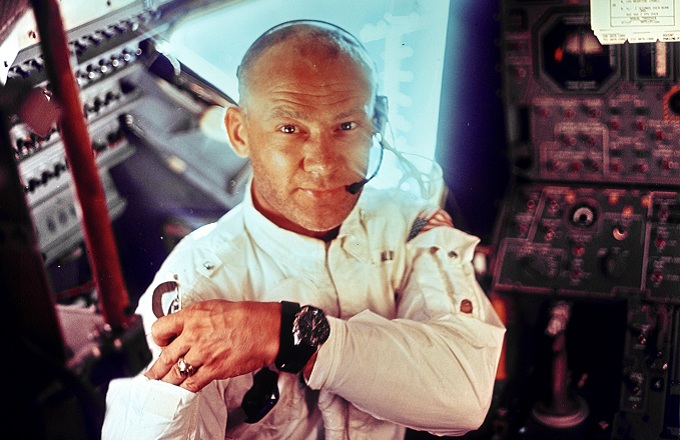
On day three, we fired our engine to slow us down enough for the Moon’s gravity to pick us up and take us into lunar orbit. Another tricky engine burn put us in the right orbit for landing on the other side of the orbit. We had estimated a 60% chance of landing successfully. But you can always abort so we had a 90% change of landing successfully. I kind of liked that 95% chance!
13 orbits later on the morning of Sunday July 20th 1969, Neil and I entered the command module of the lunar landing craft that we had named the Eagle. We separated from the command module the Columbia where Michael Collins remained. Piloting our powered descent to the Moon’s sea of tranquillity was the most complicated and critical aspect of the whole mission as we descended we saw that our landing site was full boulders. So we continued manoeuvring until we found a safe area to land. This expended a little more fuel and when we landed we had 15 seconds of fuel left. After 11 intense minutes of descent. Neil spoke the words “Tranquillity base here the Eagle has landed”.
There’s been much discussion over the last 40 years about why Neil was the first to step on the surface. It could be because he was the mission commander and in our armed services leaders are always in front of their men. It could also be because he was closer to the door. I’ll never tell which.
With Neil already on the surface and snapping photos of me I carefully backed down the ladder and partially closed the hatch. Being careful not to lock it on my way down! As I stepped onto the top of the lunar dust the first words that came to me first were Magnificent Desolation. It was a magnificent accomplishment for man to set foot on another world for the first time. Yet there was the desolation of the millions year old lunar landscape with no sign of life, no atmosphere and total blackness beyond the sunlit terrain. We spent a total of 2 ½ hours on the lunar surface collecting rocks, setting up experiments and taking a few photos.
For one experiment I was not supposed to walk in front of the solar array on the equipment. But if you look carefully at one of the photos taken by Neil you can see footprints in front of the equipment. That’s what we call condemning evidence! Another famous photo Neil took as me is known as the visor photo because you can see the reflection of the Eagle spacecraft and Neil in the visor of my helmet. People have asked me why this photo is so great. I have three words… location, location, location!
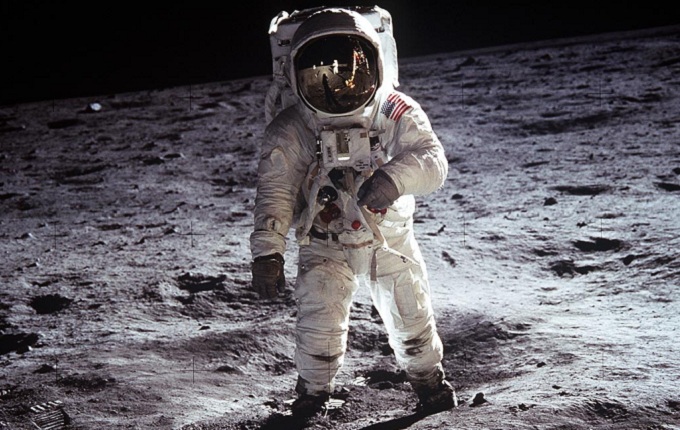
We planted the first American flag on the moon. I’m reading in the paper now that ours blew over but all the other five are still standing proud. My salute to the flag was my proudest moment. I always thought that our flag looked the best out of the six flags that had been planted there by 1972. Finally it was time to leave the surface. As we got ready to leave the surface Houston said Apollo 11 you are cleared for lift off. I couldn’t resist seeing “Roger we’re number one on the runway”. Okay so there weren’t anyone else up there and there certainly wasn’t any runway, but it did lighten things up a bit.
Nearly a billion people all over the world watched and listened as we stepped onto the lunar surface. Houston was in contact communication with us, even though we were further away that two human had ever been, we felt connected to home. The commemorative plaque we left on the lunar surface read “Here men from the planet earth first set foot upon the moon July 1969. We came in peace for all mankind”.
Since our splashdown in the specific I’ve come to realise that more than the rocks we brought back and experiments we left on the moon; the true value of Apollo is the amazing story of innovation and teamwork that went into overcoming all the obstacles to reach the moon. That effort was driven in part by competition and in part by scientific discovery. Everyone on the earth felt like they had participated in this critical journey as we landed on another celestial body for the first time in history. That feeling of participation that brought together humanity holds a value beyond measure. The world welcomed us back form the moon as heroes. However I understand that people were not cheering three guys but for what we represented. That by coming together we had accomplished the impossible.
It’s been 43 years since Neil and I walked on the moon and I still have an adventurous spirit today. I’ve been to the North Pole on a nuclear icebreaker; I went down 3810 meters or approximately 2 miles down to the ocean floor to see the Titanic in French submersible. My favourite thing to do on this planet is to scuba dive. I try and do it at least a couple of times a year when my schedule allows. In 2012 my son Andy took a photo of me hitching a ride on a whale shark. Don’t try it unless you know what you’re doing!
These days I continue my work as a global spaceman. I am passionate about forging our future in space. I have suggested two guiding principles for our space venture. One is an ever expanding human presence in space and a global leadership in space. Some may ask why we even need a space programme, because by venturing into space we make life better for everyone here on earth.
The scientific advancements and technological innovations that come from this type of research create products and technology that we have in our daily lives! They bring more convenience to people all over the world today. We must all support leader and initiatives that place importance on the subjects of science, technology, engineering and maths S.T.E.M. in our schools. Those are the foundations of any successful economy in any country in the world. Yet in the USA we aren’t doing enough to inspire young people to enter these critical fields.
Humans need to explore, to push beyond current limits just as we did 43 years ago. To make this vision a reality will require public support and co-operation. We need to make sure that the younger generation is excited about studying these S.T.E.M. subjects. We need for the next generation to be motivated to push technological boundaries to seek out new innovations.
I’m currently working on my next book which will be released by the national geographic society in spring 2013. It will be my vision for what we as a civilisation should be doing to continue our exploration beyond the moon to reach asteroids, comets, the moons of Mars and to land on the surface of Mars and to stay there permanently.
The pilgrims didn’t hang around Plymouth Rock waiting for the return trip. I strongly feel that wee need to get the world excited again about space exploration and have the pioneering spirit to reach beyond our boundaries and current capabilities. I’m hoping we can get the next generation to feel as we did back when it was a privilege to be part of the Apollo Space programme.
Apollo is the story of people at their best working together in a common goal, we started with a dream and we can do these kinds of things again. With a united effort and a great team you too can achieve great things, I know because I’m living proof that it can be done!
